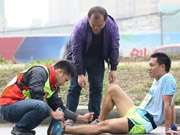


BEIJING, May 30, 2016 -- Chinese PresidentXi Jinpingaddresses an event conflating the national conference on science and technology, the biennial conference of the country's two top think tanks, the Chinese Academy of Sciences and Chinese Academy of Engineering, and the national congress of the China Association for Science and Technology, in Beijing, capital of China, May 30, 2016. (Xinhua/Ju Peng)
BEIJING, May 31 -- Chinese President Xi Jinping has warned that the country faces a major science and technology (S&T) bottleneck and a big gap in innovation capacity.
"The situation that our country is under others' control in core technologies of key fields has not changed fundamentally, and the country's S&T foundation remains weak," Xi said at a Monday S&T conference.
In his speech, which was made public in full on Tuesday, Xi set the target of China becoming a leading power in S&T by the middle of this century.
"Currently, the state needs the strategic support of science and technology more urgently than any other time in the past," said Xi.
He noted that China is highly dependent on the import of high-end new materials and patented medicines, and China is advancing research in deep sea and space exploration. They are among a number of strategic areas in urgent need of breakthroughs.
The Communist Party of China (CPC) Central Committee has outlined scientific and technological strategies until the year 2030, he noted.
He encouraged scientists and technicians to respond to major strategic demands, strive to advance research into core technologies and move to the world's S&T "high ground."
Stressing the reform of S&T management, Xi called for strengthened consultation for decision making and high-level S&T think-tanks.
Besides, major S&T decision-making should be conducted according to a constituted mechanism, rather than officials' whims, Xi said, adding that S&T experts should no longer have to follow their superiors' orders.
Xi called for a national technological innovation center with support from enterprises, and highlighted the role of enterprises in S&T innovation as "major players in innovation decision-making, research and development as well as the translation of lab results to production."
He called for a sound environment for S&T personnel. China has the world's largest army of S&T workers, which makes world-level research possible, the president noted.
Scientists should not be rushed for the sake of "making progress" and constrained by rigid systems, he said.
Monday's conference conflates the national conference on S&T innovation, the biennial conferences of the Chinese Academy of Sciences (CAS) and the Chinese Academy of Engineering (CAE), and the national congress of the China Association for Science and Technology.
Xi recalled that in January 1956, Mao Zedong and other state leaders heard reports from chief CAS scientists on sci-tech development at home and abroad, and then the CPC Central Committee initiated the call of "marching toward science."
At the national science congress in 1978, Deng Xiaoping made the important remarks that science and technology are productive forces, ushering in a "spring" for the country's science circles.
In 1995, addressing the national conference on science and technology, Jiang Zemin called on the nation to implement the strategy of rejuvenating the nation by promoting science and education.
In 2006, Hu Jintao deployed the implementation of the country's middle and long-term program for sci-tech development from 2006 to 2020, and mobilized the whole nation to build an innovation-oriented country during a national conference on science and technology.
In 2012, China's top leaders called for the country to become more innovative in science and technology and to integrate science and technology with social and economic development while attending the national conference on science and technology innovation.
During Monday's meeting, Xi said intellectual property rights must be better protected, and a distribution policy whereby knowledge has greater value should be implemented.
He listed examples of such distribution policies such as raising profits that scientists and researchers get from translating lab results to industrial production, and offering innovators various incentives including stocks, options and bonuses.
Day|Week

 China's first intelligent security robot debuts in Chongqing
China's first intelligent security robot debuts in Chongqing A Total of 3,552 Subscribers Vanish In Two Days; YouTube Closes All Doors to Users’ Inquiries
A Total of 3,552 Subscribers Vanish In Two Days; YouTube Closes All Doors to Users’ Inquiries Out of this world! Futuristic UFO-shaped yacht has its own garden and a stunning underwater viewing deck
Out of this world! Futuristic UFO-shaped yacht has its own garden and a stunning underwater viewing deck An old tea house in Chengdu
An old tea house in Chengdu Furious Customer Crushes All the Buns from Vendor Just Because He Was Given the Wrong Flavor
Furious Customer Crushes All the Buns from Vendor Just Because He Was Given the Wrong Flavor 20 post-90s couples hold ’naked marriage‘ in E. China
20 post-90s couples hold ’naked marriage‘ in E. China Female official wearing traditional Han costume to promote local tourism
Female official wearing traditional Han costume to promote local tourism Over 12,000 Runners Seek Medical Care in S China’s Marathon
Over 12,000 Runners Seek Medical Care in S China’s Marathon Six Luxury Sports Cars Totaled after Fail Attempts to Cross China’s Most Perilous Highway Linking SW China’s Sichuan and Tibet
Six Luxury Sports Cars Totaled after Fail Attempts to Cross China’s Most Perilous Highway Linking SW China’s Sichuan and Tibet Incredible Transformation: “Witch Child”Whose Parents Left Him for Dead in Nigerian Makes Speedy Recovery
Incredible Transformation: “Witch Child”Whose Parents Left Him for Dead in Nigerian Makes Speedy Recovery